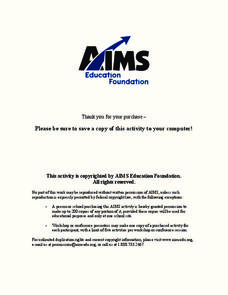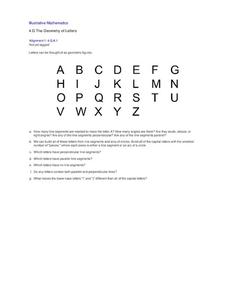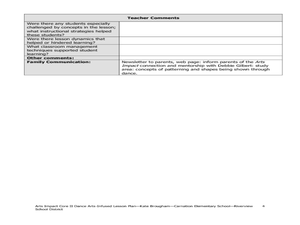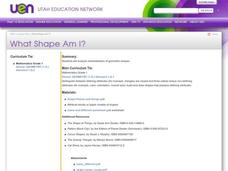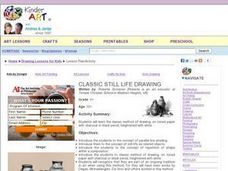Nuffield Foundation
Making a Calibration Curve for Starch Concentration
How well can your class concentrate on solutions? Scholars use colorimeter absorption to explore a starch concentration calibration curve. They add iodine to different starch solutions to see how the concentration of the solution changes.
Curated OER
Radioactive Decay Curve
Students gather and organize data. In this radioactive decay curve instructional activity, students gather data as they follow the provided procedures for rolling dice. Students chart their data and examine interval results.
Michigan Technological University
Giant Mirrors
Did you know some retailers use curved mirrors in their fitting rooms to make customers look thinner? Pupils view themselves in convex and concave mirrors to understand the difference. The resource includes big ideas for multiple age...
Curated OER
The Slope of a Curve
Students graph the slopes of a line using the intercepts. In this precalculus lesson, students identify the properties of a curve slope. They find the limit and use a graping calculator to graph their lines.
EngageNY
Normal Distributions (part 2)
From z-scores to probability. Learners put together the concepts from the previous lessons to determine the probability of a given range of outcomes. They make predictions and interpret them in the context of the problem.
Curated OER
Around the Bend
Students examine the art elements of the Inca "Large Jug." In this visual art lesson, students identify the colors, pattern, and shape of the Inca "Large Jug." Students then draw a design on a flat and curved surface and discuss the...
EngageNY
Exploring the Symmetry in Graphs of Quadratic Functions
Math is all about finding solutions and connections you didn't expect! Young mathematicians often first discover nonlinear patterns when graphing quadratic functions. The instructional activity begins with the vocabulary of a quadratic...
EngageNY
The Definition of a Parabola
Put together the pieces and model a parabola. Learners work through several examples to develop an understanding of a parabola graphically and algebraically.
Curated OER
Intertidal Field Trip
Students explore an intertidal zone. In this science lesson plan, students travel to an intertidal zone. Students collect data and create species accumulation curves.
Curated OER
How Can They Tell?
Pupils compare the characteristics of arcade tokens to those of a circulating U.S. quarter to determine how a video game can tell the difference between the two. They examine coins and arcade tokens very closely to observe the differences.
Curated OER
Blow and Go
Students discover how air can move things by using their breath. In this physics lesson plan, students hypothesize then attempt to move a pencil 1 meter using nothing but their breath. Students record data from their experiment including...
Curated OER
Introduction to Economics
Students develop the concept of supply and demand. In this economics lesson, students listen to a lecture and take notes on supply and demand. Students create a coherent set of notes about supply and demand.
Curated OER
Mirror Curvature
Students investigate parabolas as the shape of a telescopic mirror. In this Algebra I/Algebra II lesson, students explore the relationship between the coefficients of a quadratic function and the shape and position of the parabolic...
Illustrative Mathematics
The Geometry of Letters
Use the alphabet as a tool for teaching your class about geometric figures. Break apart capital letters into line segments and arcs. Classify angles as right, acute, or obtuse. Identify parallel and perpendicular lines. An excellent...
Curated OER
Why Do Gasoline Prices React to Things That Have Not Happened?
Young scholars investigate how the price of gas is determined. In this economics lesson, students analyze supply and demand and seasonal demand, create tables and graphs and reflect on consumer expectations.
Curated OER
Dancing Polygons and Non-Polygons with Patterns
Second graders study movements. In this dance lesson, 2nd graders draw patterns selecting one to represent through movement with their body.
Curated OER
Shapes and Their Insides
Learners follow a series of instructions for drawing and coloring different shapes in order to learn the difference between the perimeter and area of a polygon. Then they are asked to find the perimeter and area of a 3x4 rectangular...
Curated OER
What Shape Am I?
First graders analyze characteristics of geometric shapes. They identify, describe, and create simple geometric figures. They analyze characteristics of geometric shapes and determine the defining attributes of a circle,...
Curated OER
What Shape am I?
Students analyze characteristics of geometric shapes. They find shapes in their environment, and communicate why it is like the shape of their choice and not like another shape.
Curated OER
Grade 5: Testing for Tessellations
Fifth graders use formal geometric language to describe polygons (and other shapes) that will tessellate the plane and those that will not. Students make generalizations about the characteristics of a polygon (or other shape) that will...
Illuminations
Circumference and Areas of Circles
Middle and high schoolers listen to a scenario about a puppy and use the scenario to develop formulas in order to find the area of a circle. In this circumference lesson, pupils understand how to find the radius, diameter, area of a...
Curated OER
Applied Science - Science and Math Lab
Students investigate topology. In this Applied Science lesson plan students explore higher, more abstract mathematics using tangles. Students make topologically related shapes.
Curated OER
Classic Still Life Drawing
Provide your young artists with an opportunity to study the masters and their techniques to become skilled at drawing still life. They discuss and view images from artists like Degas and Michelangelo, practice drawing techniques such as...
Curated OER
Tennis Ball Tubes
Students determine whether the height of a tennis ball tube or the distance around the tube is greater, or whether they are the same. Using the formula for the circumference and diameter of a sphere, they discuss the word problem, and in...










